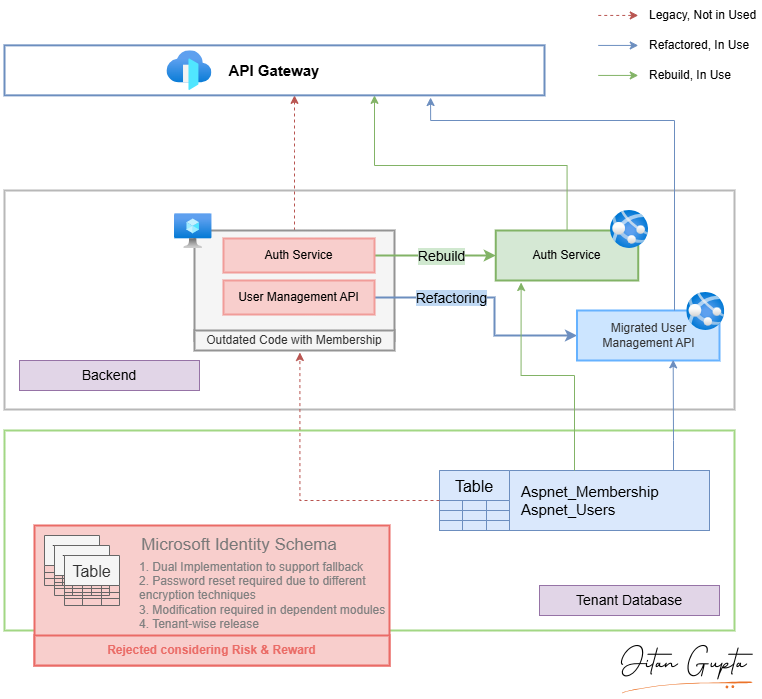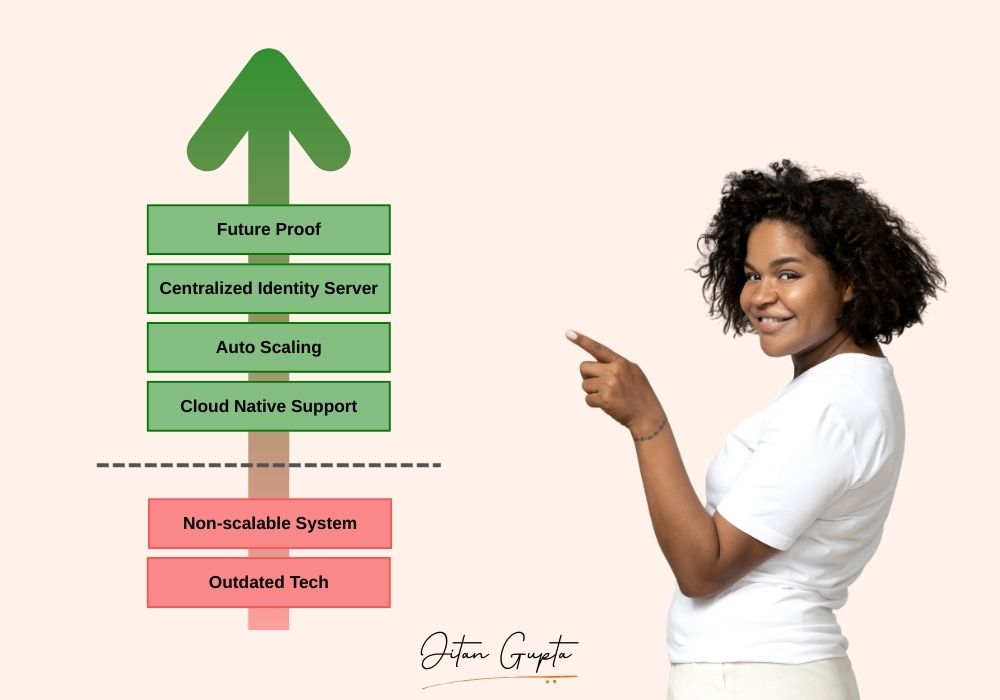Seamless User Management Migration: Future-Proofing with Azure
Executive Summary
We successfully migrated a multi-tenant system without downtime, improving scalability and eliminating technical debt. The key benefits were:
- Eliminated dependency on unsupported Microsoft Membership framework
- Enabled cloud scalability via Azure App Service deployment
- Created a centralized identity management architecture
- Maintained system availability with zero disruption for tenants
- Established a foundation for future feature expansion
The migration was accomplished with minimal risk through careful planning, proof-of-concept validation, and robust fallback mechanisms that proved invaluable during deployment.
Client Challenge
Legacy System Limitations
The client ran a complex multi-tenant app ecosystem. It included a User Management system based on outdated technology:
- Microsoft Membership: No longer supported in modern .NET environments
- Distributed Authentication: Multiple modules each maintaining separate login pages
- Technical Debt: Growing maintenance overhead and security concerns
- Feature Implementation Challenges: Required redundant updates across multiple modules, increasing maintenance overhead
- Scalability Constraints: Legacy system hosted on VM-based IIS without auto-scaling capabilities
Business Objectives
The client sought to:
- Reduce technical debt by eliminating deprecated technology
- Centralize identity management capabilities
- Streamline engineering efforts for future feature implementations
- Improve scalability to handle variable demand
- Maintain system stability throughout the transition
Solution Approach
Assessment & Strategy
After I finished analyzing the current applications, APIs, and dependencies, I crafted a migration strategy that focused on:
✅ Minimal Disruption: Ensuring tenant applications remained functional throughout the transition.
✅ Phased Implementation: Breaking the migration into manageable segments to reduce risk.
✅ Fallback Mechanisms: Building safety nets to ensure business continuity.
✅ Database Compatibility: Preserving existing schema where possible to minimize disruption.
Why This Approach?
To ensure a seamless transition, we prioritized solutions that required minimal changes for end-users while maximizing scalability. Here’s what guided our approach:
Key Strategic Decisions
Several critical decisions shaped the migration approach:
- Why We Rejected a Full Identity Migration: Despite its modern features, Microsoft Identity wasn’t the best fit because:
- All users would have been forced to reset passwords.
- Dual implementation was needed during transition, complicating development.
- Dependent modules required extensive modifications.
- Custom Identity Server Implementation: Rather than adopting a third-party identity provider that required complex data migration, I created a centralized identity layer. This layer is built on our newly migrated authentication service.
- Code Rebuild vs. Refactor: We rebuilt the authentication service while preserving existing interfaces, ensuring dependent systems remained unaffected. This allowed us to modernize the core without disrupting external integrations.

Migration Roadmap
The migration plan included:
- Initial assessment and proof-of-concept validation
- Stakeholder presentations and approval process
- Phased implementation with built-in fallback mechanisms
- Gradual elimination of Membership dependencies
- Strategic preservation of database structure
- Development of centralized identity layer
Technical Implementation
Phase 1: Authentication Service Migration
- Rebuilt authentication service in .NET Core while maintaining identical payload and response bodies
- Implemented robust fallback mechanism to legacy service
- Released new service with zero disruption to dependent systems
Phase 2: API Modernization
- Migrated User Management APIs from .NET Framework to .NET Core
- Eliminated Membership code dependencies while preserving database structure
- Leveraged existing .NET Core service infrastructure
Phase 3: Centralized Identity Implementation
- Developed UI layer on top of authentication service
- Consolidated login and SSO capabilities into centralized service
- Created foundation for unified authentication across all modules
Challenges & Solutions
Deployment Challenge
Challenge: After initial deployment, the migrated system experienced unexpected issues leading to system failure.
Solution: The fallback mechanism restored service quickly, within minutes. This shows the importance of smart risk planning.
Database Schema Challenge
Challenge: Changing the database schema means updating each tenant’s database. This could cause major disruptions.
Solution: Keep the current database structure. Remove code dependencies. This balances reducing technical debt with managing implementation risk.
User Experience Considerations
Challenge: Migrations often cause login issues and force password resets, frustrating users. Our goal was a frictionless experience.
Solution:
- Preserved Login Experience: The new authentication system maintained existing login endpoints and payload structures to ensure dependent applications continued to function without modification.
- Zero Forced Password Resets: Users could continue using their existing credentials without needing to reset passwords, avoiding unnecessary friction.
- Minimal User Impact Strategy: Since the migration focused on backend improvements, users experienced no change in their authentication experience.
- Proactive Monitoring: I closely monitored login requests post-migration to detect anomalies and ensure a seamless transition.
Business Impact
Immediate Wins
- Eliminated Legacy Dependencies: Removed reliance on unsupported Microsoft Membership.
- Cloud-Ready Architecture: New implementation deployed on Azure App Service with auto-scaling capabilities.
- Improved System Resilience: Fallback mechanisms proved effective during deployment challenges.
Long-Term Gains
- Reduced Operational Risk: By removing deprecated technology, we minimized security vulnerabilities and long-term stability risks.
- Improved Scalability: Azure App Service deployment automatically scales to meet demand fluctuations.
- Engineering Efficiency: Centralized identity management reduces duplicate implementation efforts for new features.
- Future-Ready Foundation: Architecture supports addition of modern authentication features like 2FA.
Future Enhancements
Next, we’re enhancing the UI authentication flow and expanding SSO, making access even smoother.

 R██████ ███████
Senior Director of Engineering, ████████████
R██████ ███████
Senior Director of Engineering, ████████████ 